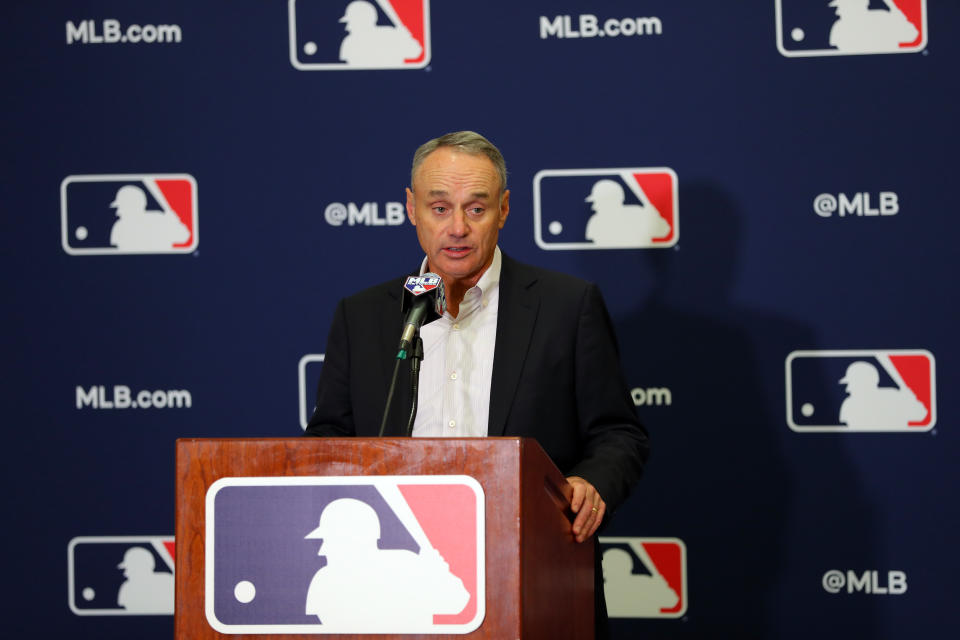How does MLB's latest salary proposal compare? It's just more of the same
Another week, another proposal about restarting baseball between Major League Baseball and the players union — and another reason to think neither side is any closer to finding common ground.
If the whole thing is starting to feel very familiar, it’s with good reason. The two sides appear to be going round and round without any drastic changes. The numbers might change — 48 games vs. 76 games, this percentage vs. that percentage — but when you boil it down, there’s not a lot of budging on either side.
The latest proposal from MLB came Monday: A 76-game season for which players would be paid up to 75 percent of their prorated salaries. They would be guaranteed 50 percent for playing the regular season, with the other 25 percent paid out if the postseason is completed.
Remember, that’s an additional pay cut on top of what’s already been agreed to. So what we’re really talking about is 23 percent of players’ usual 162-game salary on the low end and 35 percent if there is a postseason. Those numbers aren’t that much different than the league’s previous proposals.
Like the other proposals, the immediate response from players didn’t seem promising. Evan Drellich of The Athletic reports that the MLBPA regards this offer to be worse than previous ones because of the postseason contingency. Philadelphia Phillies outfielder Andrew McCutchen tweeted “lol” soon after the offer was made public. St. Louis Cardinals ace Jack Flaherty tweeted, “That’s cute.” While Roberto Perez of the Cleveland Indians asked whether owners even wanted to play this season:
Do they even want to play??? We are ready! 🤷🏼♂️🤦🏼♂️🤦🏼♂️🤦🏼♂️
— Roberto Perez (@robperez2015) June 8, 2020
Breaking down MLB’s salary proposals
The main point of contention in the negotiations to restart baseball is money — specifically, a March agreement in which players and owners agreed to prorated salaries. However, the document appears to allow owners to reopen negotiations if games would be played without fans. Owners are asking for a second pay cut from players before starting games, citing the lack of revenue from ticket buyers. The union contends that prorated salaries should stick regardless, and that the league has not proven any financial need for further cuts.
What we’ve seen throughout negotiations is neither side having a willingness to budge. The players have rejected any deal that’s not their prorated salaries. Owners, meanwhile, have made it clear the only way they’ll honor the March agreement is with a severely shortened season, reportedly 48 games. Otherwise, they want players to accept between 25 percent and 35 percent of their normal salaries.
While the numbers change between each idea, here’s what they actually add up to:
• 76-GAME PROPOSAL: MLB’s latest proposal would pay players as much as 75 percent of their prorated salaries if the postseason is played. This would put players at 35.2 percent of the original 2020 salaries if they get paid 75 percent and 23.4 percent if there’s no postseason.
• 82-GAME PROPOSAL: MLB’s original proposal involved a sliding-scale pay model, with some players near the league minimum making up to 72.5 percent of their prorated salaries. Higher-paid players would take bigger pay cuts, some making just 20 percent of their prorated salaries at the highest level. According to Beyond the Box Score’s calculation, this would see players making 23.9 percent of their 162-game salaries.
• 48-GAME SEASON: The league’s fallback plan appears to be unilaterally starting a 48-game season but keeping the full prorated salaries. This could amount to 29.6 percent of the players’ 162-game salaries.
ESPN’s Jeff Passan showed the numbers a different way, comparing total salaries that would be paid out by MLB owners:
• 76-GAME PROPOSAL: $989 million guaranteed, with an additional $443 million if the postseason is played, for a total of $1.43 billion.
• 82-GAME PROPOSAL: $1.03 billion in regular-season salary plus $200 million if the postseason is played, for a total of $1.23 billion.
• 48-GAME SEASON: $1.03 billion in salary with no additional postseason pay.
For context: MLB’s revenues in 2019 were $10.7 billion, according to Forbes. Despite that, some owners are crying poor because of the pandemic. Tom Ricketts, the Chicago Cubs chairman, said last week that teams are looking at “biblical” losses.
The players’ proposal remains a little more straightforward in that they’re steadfast in their belief they should get a prorated salary based on the number of games played. They had proposed a 114-game season that would see the regular season extend to Halloween. MLB rejected that proposal, but just for comparison’s sake, that would have paid players 70 percent of their 162-game salaries.

Where does baseball go from here?
Just looking at the percentages outlined above, it’s pretty clear that the players and owners have a large gap in front of them. The opportunity to even start a season by July 4 is all but gone now.
Fans might view this stalled discussion as a sign that we won’t see baseball in 2020, but the league will reportedly impose the 48-game game with prorated salaries, based on the March deal, if an agreement can’t be reached. That would get baseball on the field in 2020, but it could lead to more labor discord in the future.
The current collective bargaining agreement is set to expire after the 2021 season. Tensions between the league and MLBPA were high before the pandemic shut down baseball, so imposing terms of a season on players would just make that fractured relationship even more contentious.
So even if baseball does return in 2020, there’s a good chance what we’ve seen play out in recent weeks is more of a battle and not the entire war.
More from Yahoo Sports:
